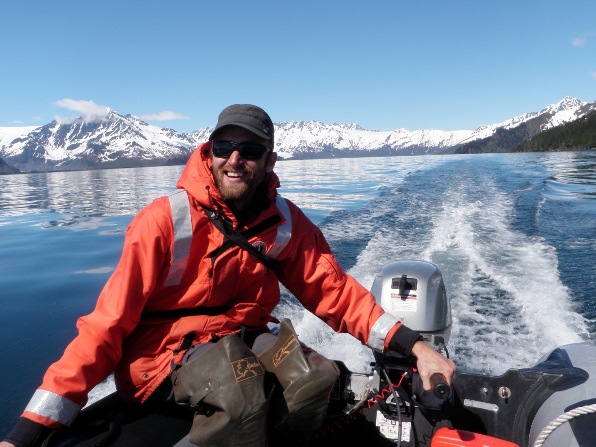Hello all you Kenai Fjords National Park research followers! My name is Sam Stark and I'm a Biological Science Technician here at Kenai Fjords. I'm writing today to give you a little insight into some of the research that's been going on in your park this summer. Our crew of two, which includes Brian Robinson, a graduate student from the University of Alaska Fairbanks, and myself, spent this field season studying Black Oystercatchers in Aialik Bay.
Some of you who aren't familiar with the coastal regions of central Alaska and the rest of the Pacific Coast may ask yourself "Now what on earth is an Oystercatcher?" Black Oystercatchers are medium sized, black (big surprise), shorebirds that inhabit the beaches and rocky coastlines from the Aleutian Islands to the Baja Peninsula in Mexico. These highly unique and interesting birds often get a bad rap and are described as "dumpy and loud" in one local kayakers guide book. This view, I often find, is generated by unknowingly spending extended amounts of time in close proximity to their nests. This usually results in a ceaseless barrage of unnerving alarm calls and dive bombs which drive even their most devoted fans (us) to use profanity against them. The truth of the matter is that they are extremely bold and intelligent birds that play a vital role in the health of the nearshore ecosystems and maybe you'd be kind of upset too if someone was within inches of stepping on your highly camouflaged nest.

Adult Oystercatcher defending nest which they make by organizing beach rocks into a structure known as a "scrape".
NPS / Brian Robinson
Our research for this summer had two objectives. Our first objective was to continue monitoring Aialik Bay's Black Oystercatcher population. Our second goal and the focus of Brian's Master's research is to pull apart some of the factors influencing productivity of this population, primarily chick diet and its effect on their fitness. You may think "that's not much of a question, oysters duh". It turns out, however, that despite their name, oystercatchers don't eat oysters. They do eat mussel, limpets, chitons, barnacles, worms and crabs. Most of these prey items require significant handling which the adults preform nimbly with their strong bills.

A Black Oystercatcher chick rests after escape from its shell (note egg tooth still attached to upper bill).
NPS / KaitlinThoresen
But what about this little ball of fluff? This is an Oystercatcher chick. As you can see that long, bright red bill which is so obvious on the adults, hasn't really reached its full potential. Oystercatcher chicks are mobile after only a day but aren't able to feed themselves for over a month. During this period the adults have to search for and remove the shells from enough food for themselves and their clutch of two to three chicks. This means that availability of high-nutrient prey items is really important for the development of these chicks.
In order to measure how much of each prey chicks are eating we use a couple of different methods. The first and most obvious, is watching them. Sitting in a turkey blind with a powerful spotting scope is where you'd likely find us come low tide each day. I find blind observations to be very meditative. The second method is drawing blood. The saying "you are what you eat" is well illustrated in the concentrations of nitrogen and carbon isotopes found in Oystercatcher blood. To determine what the chicks have been eating, we collect prey species which they are known to eat and figure out their isotopic ratios. From here, a little algebra can tell us what prey items make up the majority of their diet.

Oystercatcher takes flight from its nest near Coleman Bay in search of food for its chicks.
NPS / KaitlinThoresen.
Once we understand the diet of the group as a whole we can began to focus on the diet of individual chicks. Using measurements of tarsal (bottom leg bone), exposed culmen (bill) and relaxed wing lengths along with body weight we can track growth rates of chicks during their fledging period. Using all of this data, we hope to make conclusions about which of their prey holds the most nutritional value. This information could lead us to better understanding of the foraging and nesting needs of Oystercatchers and further benefit their conservation.
What is fieldwork like in Kenai Fjords National Park? It is long days in a tiny skiff, slaloming icebergs, searching for nests. It is picking through gravel beaches looking for three rocks that are kind of egg shaped. It is looking like we've totally lost our marbles when we're searching beaches for these invisible little guys. Working in the backcountry in Kenai Fjords means living and working in one of the most beautiful places in the world. I've gained a lot of appreciation for these tough little birds, even if they are dumpy, and I hope you have too.

A day in the office for the Black Oystercatcher crew.
NPS / Sam Stark
